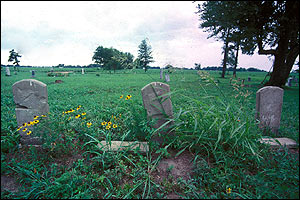Listed in Arkansas Register of Historic Places on 09/04/96
SUMMARY
Wilson Cemetery is being nominated to the Arkansas Register of Historic Places under Criterion A for local significance for its role as the primary cemetery for the residents of Trumann during the town’s formative years and its subsequent association with the early history of the town and surrounding community.
ELABORATION
Although the oldest tombstone found in the cemetery dates to 1902, the first use of the Wilson Cemetery is believed to have occurred in the last few years of the 19thCentury. According to local oral history, the cemetery was formed when a local trapper, who was boarding with the Sean Wilson family, died and was buried on the ridge west of the Wilson’s house. The cemetery was subsequently known as Wilson Cemetery even though the actual property was donated by Joseph Chaffin and John Breedlove (each initially donating one-half acre apiece and later two acres each for a total of five).
Although the cemetery is located in Craighead County, most of the individuals buried there were citizens of Trumann and the surrounding communities in Poinsett County. The town comprising Trumann was originally known as Mosher. The name was changed to Weona in 1902, and finally Trumann in 1917, when the town was incorporated. According to local oral history recorded by the Area Chamber of Commerce, the people first settling present day Trumann were loggers. However, as the timber was cleared and the swamps drained, the town stabilized as an agricultural community.
According to Dallas T. Herndon’s Centennial History of Arkansas, the population of Trumann (spelled "Truman" in his account) in 1920 was 2,598. Herndon further noted, "its principal industry is lumbering and the manufacturing of cooperage material, though it has a bank, an ice factory, electric light, a modern public school building and is a trading center for a large farming district." The growth of Trumann was undoubtedly connected to its location on the St. Louis and San Francisco Railroad. The railroad afforded transportation of the various timber products and attracted industries such as the Singer Company, which built a factory in Trumann in 1910, and constructed several four-room houses for its employees.
Trumann never had its own community cemetery due to the high water table in the area. Older citizens of the town recount stories of freshly dug graves filling with water before the funeral services could be completed.
As a result, most of the early residents of Trumann and the "Sunkenlands" of the St. Francis River were buried in various cemeteries situated on higher ground afforded by nearby Crowley’s Ridge.
SIGNIFICANCE
Wilson Cemetery is being nominated to the Arkansas Register of Historic Places underCriterion A for local significance for its role as the primary cemetery for the residents of Trumann during the town’s formative years and its subsequent association with the early history of the town and surrounding community.
BIBLIOGRAPHY
Herndon, Dallas T. Centennial History of Arkansas. Chicago-Little Rock: The S. J. Clarke Publishing Company, 1922.
